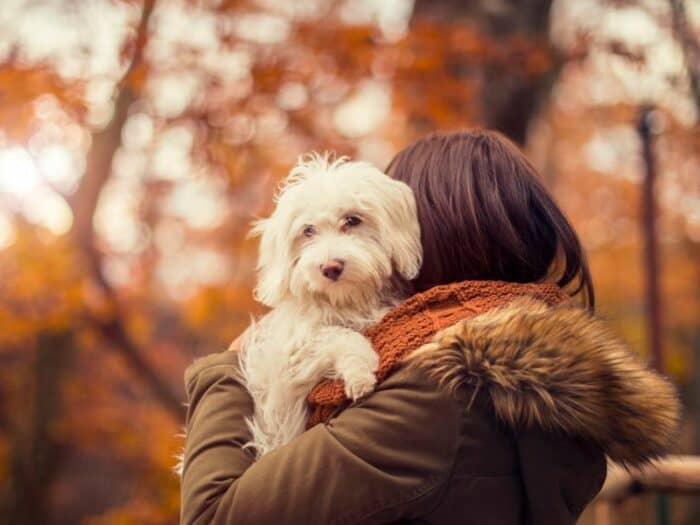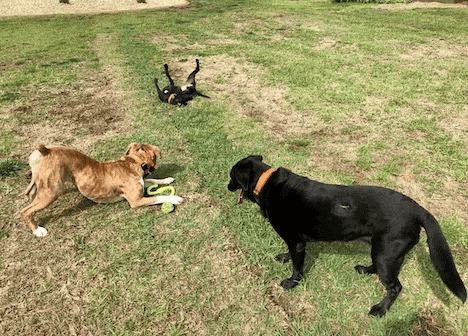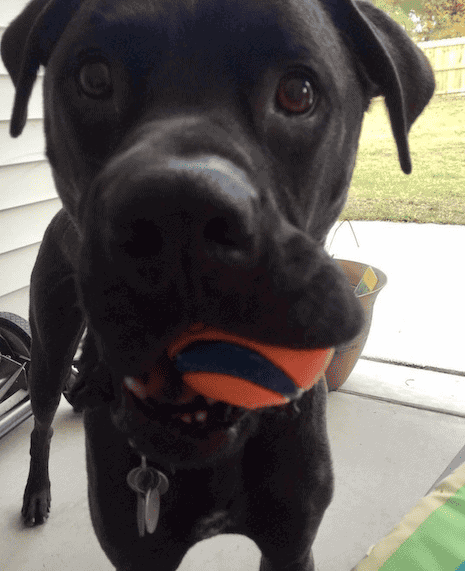This post may contain affiliate links. We may earn money or products from the companies mentioned in this post.
It’s no secret that we love our dogs, but how do I tell my dog I love him in dog language, so that he actually understands?
Well, the secret sauce is in loving your dog in the language they understand best – which is their own!
While deciphering dog language in general is a good starting point, every dog has their unique preferences as far as love messages are concerned.

That makes it important to understand YOUR particular dog’s needs and wants.
That’s why in this blog post, we’ll first give you a breakdown of how to read dog body language in general.
Next, we’ll feature different categories of doggie love languages you can pick and choose from to customize love messages for your particular dog(s).
Last but not least, I’ll share examples of how I tell my three dogs Missy, Buzz and Wally I love them in their very own dog language!
How To Read Dog Body Language
Coming up, we’re going to dive into the different body parts of a dog and look at their respective meanings when they’re in different positions.
That said, it’s really important not to focus on just one body part, but on the dog’s body as a whole.
For example, just because a dog is wagging their tail doesn’t necessarily mean they’re happy!
You’ll also have to interpret the rest of their body, including how relaxed or stiff it is along with their facial expressions.
The Body
Let’s start with the body as a whole.
A dog’s posture tells you a lot!
If their body is relaxed, they’re happy and are having a good time.

Bella, Chester and Macy, three of my former pet sitting clients, all in a playful, relaxed mood.
If their entire body is wiggling, that’s a sure sign of a joyous dog who couldn’t be any happier. This happens a lot when dogs are excited their owners are home, especially after a longer absence.
Think vacation, business trip or military deployment…or just an hour after a grocery run!
If their paws are on the ground, their butt’s in the air and their tail is wagging, your dog is doing what’s called a “play bow” and is playful and in a silly mood.
The same applies if they’re rolling around on their back and are exposing their belly.
That’s actually a huge compliment to their owner or handler because exposing the belly makes them vulnerable – and they only do that around people they trust.
My girl Missy in a play bow.
Missy is in a happy, silly mood.
Happy Wally on a hotel bed.
But if a dog’s body is stiff or barely moving and leaning forward, potentially with raised hackles and all paws on the ground, that’s a different story.
This posture means that they’re alert and:
- On the verge of lunging or attacking (someone or another dog/prey animal)
- Pointing game (gun dogs, especially bird dogs, do that)
If the dog is trembling, they’re scared (and potentially cold).
If they’re lifting a front paw, they’re unsure of the situation (unless they’re a gun dog who’s pointing their prey).
Your Dog’s Eyes
If your dog makes eye contact with you and exchanges a long, loving gaze with soft eyes, he’s happy and content.
But if he fixates you and stares you down along with a stiff body, he’s not happy.
If the dog’s eyes are bugging out and you see the whites of their eyes, this means that the dog is stressed and anxious.
Generally speaking, your own dog will probably not stare you down, at least not if you’ve bonded with your pup.
That said, never stare into the eyes of a dog you don’t know! Dogs interpret that as aggression on your part.
I remember my mom staring into the eyes of my dog Buzz the first time she met him. He was around a year and a half at the time and started fixating her in turn while growling and snarling.
Back then, my mom was not a dog person and was super shocked by his reaction.
Obviously, she didn’t mean any harm at all, but she just didn’t know any better. Suffice to say she learned her lesson and never did that again.
Ever since, she’s come around and actually enjoys being a doggie grandma these days.
My mom cuddles with my dog Wally. His entire body is relaxed, including his tail, ears and eyes.
The Lips, Teeth, Tongue & Mouth
The situation in which your dog uses their lips, teeth, tongue and mouth should make it easy to analyze their behavior.
If he’s licking and/or smacking his lips and drooling prior to mealtime or getting a food reward, he’s probably anticipating the food or treat.
Wally with a tasty pig ear dog chew.
If the pup is happily handing out kisses, they’re in a good mood and enjoy being around you.
Former dog walking client Bailey loved showering me with happy, enthusiastic kisses after our walks.
But if they exhibit that behavior without the presence of any food or treats, they’re likely nervous or scared.
If your dog’s mouth is open while they’re calmly sitting, lying down or wiggling their body, they’re happy and relaxed.
From left to right: happy doggie friends Shade, Missy and Buzz are taking a break from playing.
When they’re yawning while lounging on their bed or the couch, they’re probably tired or bored.
But if they’re yawning excessively combined with licking their lips and drooling, they’re either frustrated, nervous or stressed.
If the dog is growling, snarling and showing his teeth, it’s obvious that he’s not having a good time. As a matter of fact, he’s sending a warning message that he’s about to attack.
You can also tell if a dog is happy, alert or aggressive by their type of bark and its intensity.
If it’s soft and playful, they’re having a good time.
If it’s a repetitive, quick bark, the dog’s alert.
But if it’s a deep, lower sounding bark or even a growl, you’re likely dealing with an aggressive dog.
The Ears
Dog ears without any tension in their natural position suggest a relaxed, happy dog.
This can look different depending on whether or not your dog has cropped ears or naturally floppy ears.
Ears pinned to the side or the back of a dog’s head in combination with a lowered, cowering posture means they’re nervous, shy or sad.
But an aggressive dog whose head is lowered can also have their ears pinned back.
Ears pointed forward means the dog is alert and curious.
Former pet sitting client Husky Piper in an alert state of mind.
Missy & Buzz are attentive and curious about what’s coming next in our training session.
The Tail
A dog’s tail can tell many stories, especially in dogs who have an actual tail and not just a nub.
Let’s start with a bent, tucked tail. That means your dog is anxious or nervous, and is not having a good time.
On the other end of the spectrum is a stiff tail held high. This means the dog is alert.
For example, when he has a strong prey drive and spots a squirrel, rabbit, cat, etc.
Or if he’s reactive and spots another dog, pet, human or specific object like a bike or a car, depending on his reactivity trigger(s).
Another position is a wagging tail.
This can mean several things depending on the speed of the wag and of its direction:
- Quick wags to the right or allover helicopter wag: Your dog is happy and excited about what’s going on.
- Slower, stiffer wag to the left: Your dog is frustrated, alerted or even about to attack.
How To Say I Love You In Your Dog’s Language
Now that we’ve looked at dog body language in general, let’s shift over to different categories of love messages for YOUR dog.
They all include your dog’s body one way or another, and your dog’s respective body language will tell you if he’s having a good time or not, i.e. if he’s picking up on your attempts at telling him you love him.
This is particularly helpful when you’ve just brought a new dog home to live with you and don’t know them quite yet.
Spending Quality Time Together
The best way to tell your dog you love him is to spend quality time together doing things your dog enjoys.
As a matter of fact, sharing quality time is going to strengthen the bond between yourself and your dog.
However, quality time can mean different things for your dog.
For some dogs, this can be playtime, going for a car ride, walking, hiking, jogging or any other activities such as:
- Trick training
- Swimming
- Dock diving
- Agility
- Dog dancing
- Canicross
- Skijoring
…you get the idea.
If your dog is a working dog, one of the best ways to tell your dog that you love them is giving them a breed-specific job to do.
Because nothing is worse to a high energy dog than boredom and being under exercised!
This could be as simple as having them carry a dog backpack on your daily walks and weekend hikes.
Other jobs are hunting, herding, protection work like Schutzhund or nosework related activities.
Physical Touch
For other dogs, quality time can also be physical touch.
For example:
- Butt scratches
- Ear scratches
- Belly rubs
- Cuddling
- Brushing
It’s the equivalent of a massage and most dogs really enjoy this type of physical touch from their owners.
Of course there are some pups who aren’t crazy about getting brushed, but your dog will let you know. If their body turns stiff as you brush them, you’ll know not to overdo it.
Some dogs also really enjoy getting a bath while others will put up a fight anytime you mention the b word.
By the way, most dogs don’t enjoy getting hugs or kisses on the face. You can tell if they’re trying to escape, lean away from you or growl.
That’s why you shouldn’t encourage kids to hug dogs, especially strange dogs!
However, a few pups don’t only like hugs and kisses, they’ll actively ask for them – again, in their very own way!
One of my former pet sitting clients, Great Dane Shaun, LOVED getting kisses on his neck and would always nudge you for them.
It was the sweetest thing ever.
Again, know your dog and their preferences as far as touch is concerned!
Your Tone of Voice
Many dogs enjoy verbal praise in a cheerful, happy and upbeat tone.
For example, for listening as you ask them to “leave it”, “sit” or “go to their place”.
Some dogs even enjoy “baby talk” while others don’t care for that kind of high pitched sound at all and prefer calmer, lower sounds.
Feeding & Treating
For food-motivated dogs, their feeding routine is a big deal.
That makes the person who feeds them regularly one of their best friends ever!
Those types of dogs are also eager and happy to work in return for food rewards.
Then again, this approach won’t work as well for dogs who respond better to a favorite toy or TLC.
You’ll notice by how enthusiastic they are about either option.
Missy & Buzz with Mia & Desi, all calmly waiting for a yummy treat.
How I Tell My 3 Dogs I Love Them
Ok, now it’s time for some concrete examples of how I tell my dogs Missy, Buzz and Wally I love them in dog language!
Missy and Buzz were from the same litter of Boxer mixes. They looked very similar but couldn’t have been more different!
And my current pup Wally shares some of Missy’s preferences but certainly not all of them.
Buzz’s Love Language
Let’s start with Buzz.
My ball-crazy dog Buzz absolutely LOVED playing fetch. He also jumped into the water to retrieve his favorite chuck-it ball, but he preferred playing fetch on dry land.
I could make him happiest whenever I tossed his ball for him!

Buzz and his favorite fetch toy, the chuck-it ball.
He would cuddle for about 5 minutes on the couch, then he’d get up and reposition himself a few feet away from the rest of us (humans and Missy).
Buzz hanging out on the couch on his own terms
He accepted being brushed but loved a good butt scratch!
Since I knew that, I didn’t “force” cuddles on him and didn’t brush him longer than necessary.
When he had the choice between a toy reward and a food reward, he chose his toy most of the time.
UNLESS it was something extra stinky like a green tripe treat or a fish dog treat!
Missy’s Love Language
While Buzz loved playing fetch, his sister Missy couldn’t have cared less!
She actually didn’t care too much for most dog toys and whenever she picked one up, she lost interest very quickly – UNLESS someone tossed it into the water.
Missy would tirelessly retrieve any toy from any body of water because her favorite activity was swimming.
So it always made her day when I booked a swim session at a local doggie pool!
She also loved getting brushed, snuggling on the couch, leaning into people for TLC and eating!
It didn’t matter whether it was kibble, canned dog food or raw dog food that made it into her bowl, she inhaled everything.
She always reminded me of a food-crazy Lab!
Missy at the doggie pool wearing a doggie swim vest.
Wally’s Love Language
My current dog Wally is the same way – he LOVES to eat and is not big into playing fetch either.
Occasionally, he’ll bring back a new dog toy that I throw for him, but it’s rare.
Just like Missy, he’s not crazy about toys in general – unless they’re stuffed animals he hijacks from store shelves!!
He surprised me with that “activity” when I fostered him and took him to a pet retail store to socialize him. He was super quick at grabbing the stuffy and would not let go of it!
He’s made some progress in the “leave it” department, but I still have to watch him like crazy and keep him on a short leash when we walk past the stuffed animal aisles in pet stores.
When we’re back in the car or at home, he shreds the stuffie and loses complete interest once he’s “killed” it.
So one of the biggest joys for Wally is when I give him a stuffie he can shake and shred!
Wally with a stolen plush dog toy he grabbed on his way to getting his nails trimmed at a local pet retail store.
Very much unlike Missy, he gracefully hops over every single puddle we encounter on our walks to avoid getting wet paws.
We’ve taken him on several summer trips to the ocean, but while he’s learned that water is refreshing, he only stays in it long enough to cool off. As in a few minutes!
But Wally loves hiking and spending time outdoors. I take him on lots of dog backpack hikes to help burn his energy.
Wally on a backpack walk in horse country.
Wally also thrives on physical touch!
He’s a total cuddle bug who loves snuggling up to me (and other people!), leans in for TCL even from his vet, and thoroughly enjoys being brushed.
Wally and I snuggle on the couch.
Bottom Line
So, now that you know the different love languages of my dogs, how do you tell YOUR dog you love him or her?
Do you take them on extended backpack walks, swim sessions at a doggie pool and snuggle up on the couch with them?
Or do you know that they’re not big on cuddling and prefer to sleep at your feet?
Either way, it’s important to understand that every dog has their very own love language.
If you recently welcomed a new furry friend into your life, you won’t know all of their preferences quite yet and will have to expose them to different activities.
Once you do, watch your pup and see how they react to different stimuli.
Do they love a good game of fetch but not necessarily in the water?
Do they enjoy belly rubs but don’t care about getting brushed?
Do they only like stuffed toys they can shred but don’t care for chuck-it balls?
Do they respond well to enthusiastic verbal praise or do they prefer a calmer environment?
Either way, we’d love to hear from you and your dog’s love language in our comment section below this blog post!
Save To Pinterest

Top Picks For Our Puppies
- BEST PUPPY TOY
We Like: Calmeroos Puppy Toy w/ Heartbeat and Heat Packs – Perfect for new puppies. Helps ease anxiety in their new home. - BEST DOG CHEW
We Like: Mighty Paw Naturals Bully Sticks – All of our puppies love to bite, nip, and chew. We love using Bully Sticks to help divert these unwanted behaviors. - BEST DOG TREATS
We Like: Crazy Dog Train-Me Treats – We use these as our high-value treats for our guide dog puppies. - BEST FRESH DOG FOOD
We Like: The Farmer’s Dog – A couple months ago we started feeding Raven fresh dog food and she loves it! Get 50% off your first order of The Farmer’s Dog.
Check out more of our favorites on our New Puppy Checklist.



